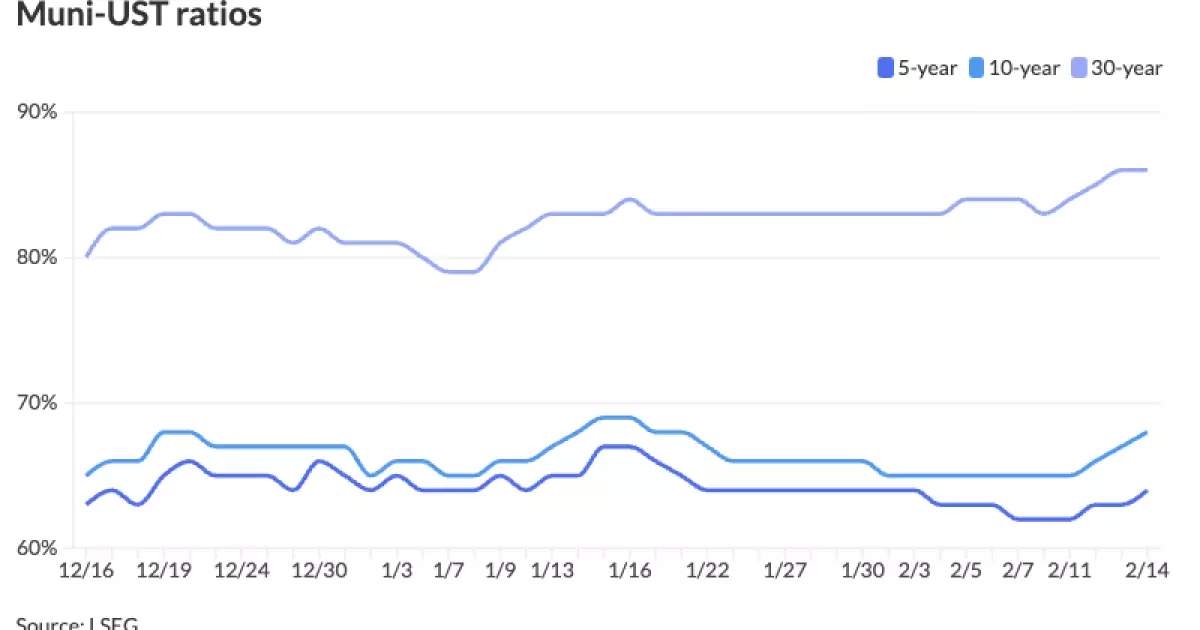Municipal Bond Market Analysis: Current Trends and Future Outlook

The municipal bond market is witnessing notable developments as trends fluctuate in response to macroeconomic indicators and interest rate dynamics. With a smaller new-issue calendar looming, several key factors are contributing to changes in the yield curves and investor strategies within this sector.
The recent dip in U.S. Treasury yields has proven beneficial for municipal bonds, which tend to be sensitive to changes in the broader interest rate environment. As highlighted by strategists from Bank of America (BofA), recent employment and consumer price index (CPI) reports have significantly influenced this shift. The January employment data interrupted a Treasury market rally, suggesting that investors are closely monitoring employment trends as indicators of economic health and inflationary pressure.
However, although the job report impeded further gains, upcoming inflation data is anticipated to prompt what is known as “bear steepening” of the Treasury curve. This phenomenon occurs when short-term rates increase at a faster pace than long-term rates, reflecting investors’ anticipation of rising inflation and consequent interest rate hikes. In light of these developments, Barclays’ strategist, Mikhail Foux, mentioned the challenging conditions surrounding municipal bond trading, suggesting that the market is likely to experience significant volatility as participants react to the fluctuating news cycles around inflation and fiscal policies.
A key theme emerging from the current market analysis is the strong supply/demand dynamic in the municipal bond realm. Although bond issuance is set to drop to an estimated $5.5 billion in the upcoming week due to a shorter holiday, experts maintain that supply is expected to remain robust throughout February. The Bond Buyer’s 30-day visible supply indicates a healthy $10.42 billion, suggesting that many investors are willing to absorb new issuance amid favorable buying conditions.
With substantial volumes of redemptions and coupon payments flooding the market, demand for municipal bonds seems resilient. BofA strategists have noted a resurgence in refunding activity, particularly as investors seek to capitalize on earlier market rallies. Between mid-January and early February, a significant drop of approximately 35 basis points in the 10-year municipal yield has coincided with $4.2 billion in refunding volumes. This illustrates a strategic shift among bondholders who are evaluating favorable refinancing opportunities in a declining yield environment.
Yield Curve Steepening and Risk Management
In recent weeks, there has been a marked steepening of the municipal yield curve, as illustrated by the AAA curve’s performance. The difference in yields between short and long maturities has widened, indicating that investors are adopting a more defensive position in terms of duration exposure. This cautious stance is mirrored in the municipal-to-U.S. Treasury (Muni-UST) ratios, which have shown slight deterioration but remain in a manageable range—63% for two-year bonds and peaking at 86% for 30-year bonds.
These ratios are particularly pertinent for investors navigating potential interest rate hikes. The steepening of the slope—now at 37 basis points for the 1s10s AAA slope compared to a more inverted -70 basis points a year ago—signals that investors are wary and are calibrating their portfolios to mitigate duration risk. Such a strategic approach allows municipal investors to remain agile in an unpredictable economic climate.
Outlook for Upcoming Issuance
Looking ahead, the upcoming new-issue calendar for municipal bonds appears active, with anticipated issuance totaling approximately $5.535 billion. High-profile deals are set to dominate the negotiations, with Miami-Dade County’s $526 million airport revenue bonds taking center stage. Other notable issuances include Pennsylvania’s $500 million for Economic Development and Infrastructure projects.
These developments point towards a continuously evolving landscape where interest from both retail and institutional investors could stimulate market resilience. As various entities prepare to issue bonds, strategic pricing and investor responsiveness will play pivotal roles in determining market efficacy in the face of prevailing economic headwinds.
Overall, the municipal bond market is navigating a complex tapestry of influences, such as macroeconomic data, interest rate shifts, and evolving investor sentiments. As economic circumstances dictate the narrative, bond market participants must remain vigilant and adaptable to leverage opportunities while effectively managing associated risks. With a backdrop of strong demand and a healthy outlook for new issuance, investor preparedness will be critical in successfully maneuvering this challenging landscape in the coming months.





